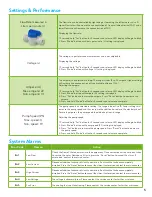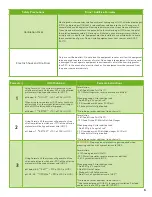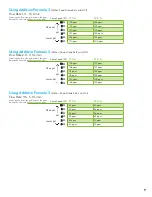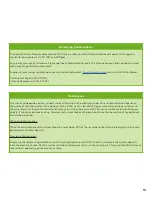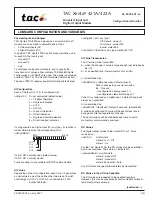
6
Safety Precautions
Brine / Additive Formulas
Ventilation Risks
Electrolyzed water contains small quantities of hydrogen gas (H2), chlorine dioxide gas
(ClO2), and ozone gas (O3) that is released from solution into the air. These gases, if
accumulated, can be explosive. Electrolyzed water contains free chlorine molecules.
Free chlorine molecules have the potential to form chlorine gas (Cl2) when the pH of
the solution becomes acidic. Chlorine gas, if inhaled, can cause respiratory irritation
or injury and is a health risk. Equipment must be installed in a ventilated area to avoid
the accumulation of gases. Do not install equipment near heat sources over 400°C
(750°F)
Electric Shock and Fire Risks
Only use certified outlets. Do not place the equipment in water or allow the equipment
to be exposed to external sources of water. Do not operate equipment if electric cord
is damaged. Do not operate equipment in environments of relative humidity greater
than 95%. In the event of an electric shock or fire, equipment must be removed from
the power source immediately.
Formula #
HOCl Solution
Formula Instructions
1
Using Formula #1 the system will generate a free
chlorine solution in which over 25% of the chlorine
molecules will be hypochlorous acid (HOCl).
p
H below 8
**
GOOD**
>25% of FAC is HOCl
When using reverse osmosis (RO) water that has a
pH less than 6 as the system inflow water, the pH
of the HOCl solution will be improved.
pH below 7 **BETTER** >70% of FAC is HOCl
Formulation
• 28% Food Grade Salt (NaCl).
• 72% Water (tap water, reverse osmosis or distilled)
When preparing 2-Liter additive tank:
1. Add 550 g (≈2 cups) of salt*
2. Fill remainder with water (1400 mL)
3. Shake until salt fully dissolved
* No iodine or other additives (ie. kosher salt)
2
Using Formula #2 the system will generate a free
chlorine solution in which over 70% of the chlorine
molecules will be hypochlorous acid (HOCl).
pH below 7 **BETTER** >70% of FAC is HOCl
Formulation
• 28% Food Grade Salt (NaCl).
• 72% Food Grade 5% White Distilled Vinegar
When preparing 2-Liter additive tank:
1. Add 550 g (≈2 cups) of salt*
2. Fill remainder with 5% distilled vinegar (1400 mL)
3. Shake until salt fully dissolved
* No iodine or other additives (ie. kosher salt)
3
Using Formula #3 the system will generate a free
chlorine solution in which over 90% of the chlorine
molecules will be hypochlorous acid (HOCl).
pH below 6.5 **BEST** >90% of FAC is HOCl
pH 4.5-5.5 **OPTIMAL** >99% of FAC is HOCl
ATTENTION:
Proper personal protective gear required when
preparing additive with hydrochloric acid (HCl).
Formulation
•
2
1.5
% food grade salt (NaCl).
• 7
5
% Water (tap water, reverse osmosis or distilled)
•
3.5
% hydrochloric acid (HCl).
When preparing 2-Liter additive tank:
1.
Add
430
g (≈2 cups) of salt*
2.
Add 1
5
00
mL of water
3.
Shake until salt fully dissolved
4.
Add
70
mL of hydrochloric acid (HCl)**
* No iodine or other additives (ie. kosher salt)
**Use technical grade HCl (32%) for general sanitation. For food
contact, must use FCC grade HCl (35-37%).





